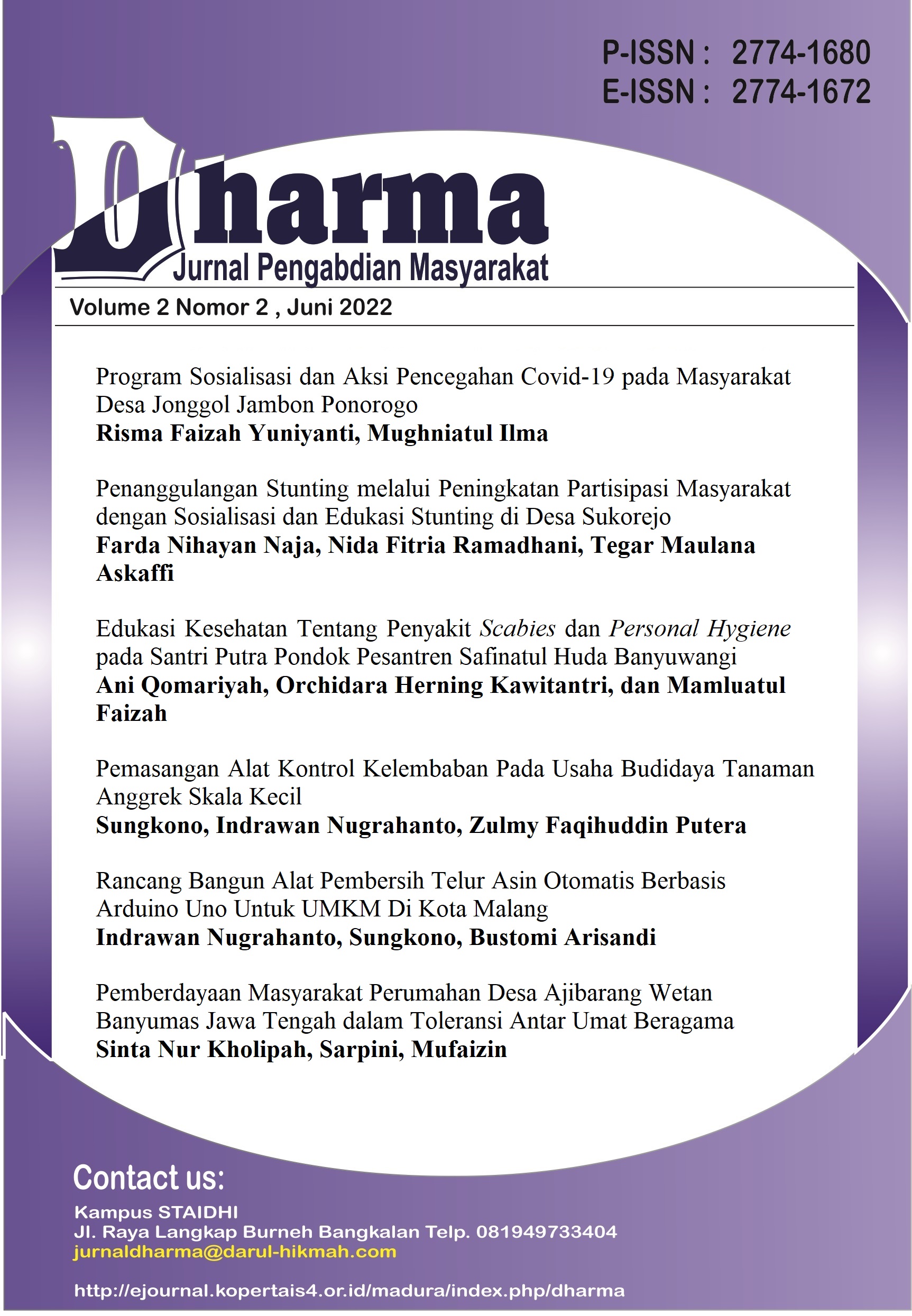Pemasangan Alat Kontrol Kelembaban Pada Usaha Budidaya Tanaman Anggrek Skala Kecil
DOI:
https://doi.org/10.35309/dharma.v2i2.5658Keywords:
Greenhouse, ESP32, SHT11, Nozzle, HumidityAbstract
The installation of this equipment can help control the humidity process for orchid cultivation in small-scale greenhouses by entering the humidity values ​​that have been determined, with values ​​of  60%, 70%, and 80%. After that, it is processed by the ESP32 as the controller center, then the LCD (Liquid Crystal Display) will show the current humidity display, then the sensor (SHT11) will read the humidity value if the humidity setpoint is below a predetermined value then the motor is on and the nozzle is working, humidity has reached the desired setpoint then the motor will turn off and the nozzle will stop. The goal to be achieved is to maintain the humidity of orchids in the greenhouse so that it remains stable according to standards and regulations, because in this greenhouse,  to maintain plant humidity is a very crucial thing for orchid cultivation because at the time it was still using human power manually with a water hose. We developed this tool to keep the humidity steady by using a nozzle that makes it a mist of water. By using a system that runs automatically, making it easier for business actors to use this tool and has time efficiency. In its installation, the tool is able to generate humidity through the nozzle using a reference to increase the hysteresis value in the control circuit and get an output that oscillates in the setting point area so that the humidity rises according to the setting point, this is because the water misting process in the test conditions cannot be immediately lost, thus affecting the test resultsReferences
Ayub S. Parnata,. “Panduan Budidaya Dan Perawatan Anggrekâ€, Agromedia Pustaka, 2005
Dwiyani,. R. 2013. Induksi Kalus pada Tanaman Anggrek Vanda tricolor Lindl. Var. Suavis Upaya Penyediaan Target Transformasi Melalui Argobacterium tumefaciens. Jurnal Agrotropika. 18(2) 73-76.
Haidar, Muhammad. 2014. Rancang Bangun Alat Pengendali Kelembaban Tanah Buah Tin menggunakan Mikrokontroler AVR. Diploma III. Palembang :Politeknik Negeri Sriwijaya.
Hakim, Zainal, Imamul Muttaqin, and Mudarris Mudarris. "Revitalisasi Jembatan Desa sebagai Akses Aktivitas Perekonomian Desa Bangpindah Kecamatan Galis Bangkalan." Dharma: Jurnal Pengabdian Masyarakat 1.1 (2020): 38-48.
Nuswantara, Dekita.2017. Desain Sistem Monitoring Pengontrolan Suhu, Kelembaban dan Sirkulasi Air Otomatis Pada Tanaman Anggrek Hidroponik Berbasis Arduino Uno. Jurusan Teknik Elektro, Jember: Universitas Muhammadiyah Jember
Ramdhani, MohAbabiel.2016. Alat Pengontrol Suhu dan Kelembaban pada Budidaya Tanaman Anggrek Menggunakan Kontroler PID Berbasis Arduino Mega 2560. Sarjana thesis, Universitas Brawijaya.
Seto, A., Arifin, Z. and Maharani, S.2015. “Rancang Bangun Sistem Pengendali Suhu dan Kelembaban pada Miniatur Greenhouse menggunakan Mikrokontroler Atmega 8â€, Prosiding Seminar Tugas Akhir FMIPA UNMUL Samarinda
Syadza, Oisthina.2018. Pengontrolan dan Monitroring Prototype Green House Menggunakan Mikrokontroller dan Firebase : Telkom university
Trihandoko, M. F. 2015. Penggunaan Sensor SHT11 sebagai Pendeteksi Suhu Ruang Inkubator Penetas Telur Disertation, Dept. Electrical Engineering., Jakarta : State Polytechnic.
Widodo, Ira Niken. 2013. Prototype Alat Pengontrol dan Monitoring Suhu Serrta Kelembaban Pada Ruang Budidaya Jamur Tiram. Diploma III. Palembang : Politeknik Negeri Sriwijaya.
Wiyanto, Ari.2018.Otomatisasi Alat Penyemprot Tanaman Anggrek Otomatis Berdasarkan Kondisi Suhu Dan Kelembaban, Jurusan Sistem Komputer. Balitar : Universitas Islam Balitar
Downloads
Published
How to Cite
Issue
Section
License
Copyright (c) 2022 Dharma: Jurnal Pengabdian Masyarakat

This work is licensed under a Creative Commons Attribution-ShareAlike 4.0 International License.

This work is licensed under a Creative Commons Attribution-ShareAlike 4.0 International License.






